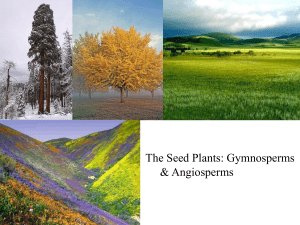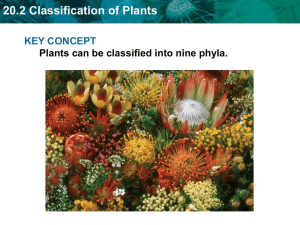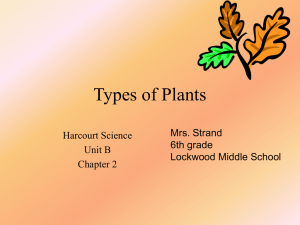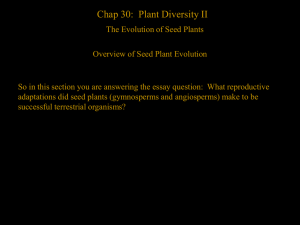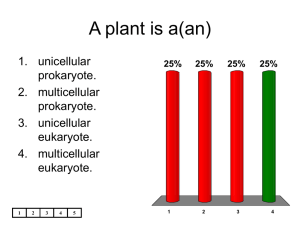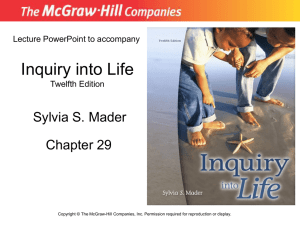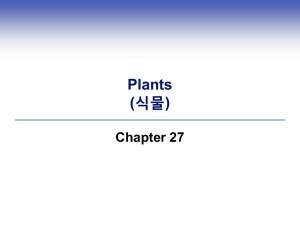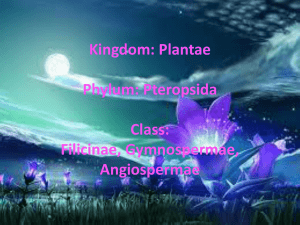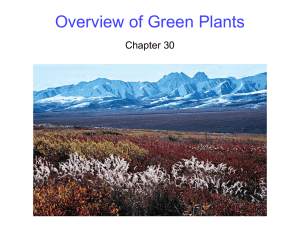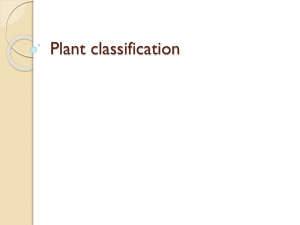Seed Plants
advertisement
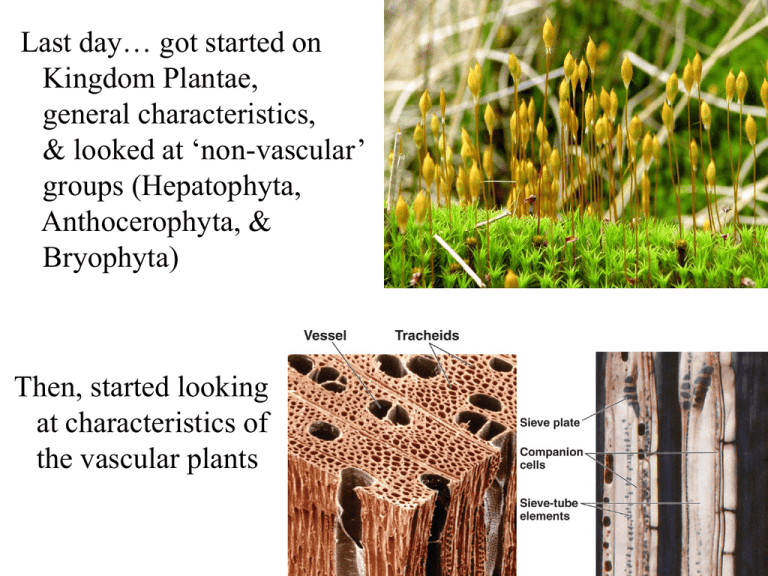
Last day… got started on Kingdom Plantae, general characteristics, & looked at ‘non-vascular’ groups (Hepatophyta, Anthocerophyta, & Bryophyta) Then, started looking at characteristics of the vascular plants Vascular plants evolved specialized roots to absorb water & minerals from the soil - and specialized leaves, microphylls (small, single vein) in lycophytes & megaphylls (large, branched veins) in most vascular plants Another innovation was sporophylls, modified leaves bearing sporangia Some seedless vascular plants (and all seed plants) became heterosporous: megaspores for female gametophytes, males from microspores Seedless vascular plants placed in 2 phyla: Phylum Lycophyta – Club mosses, spike mosses, quillworts – 1200 spp. - club mosses & spike mosses produce clusters of sporophylls called strobili - some are epiphytes (on other plants), quillworts are aquatic Phylum Pterophyta – ferns, horsetails & whisk ferns - 12,000 species (15 horsetails, 7 ‘whisk ferns’) Ferns widespread, but primarily in moist areas, may reach tree size - horsetails may be abundant in temperate areas, hollow stems with silica (‘scouring rush’) - whisk ferns may be ferns that lost leaves, roots? Success of seedless vascular plants may have caused an ice age… and global warming Ferns & other seedless vascular plants not of huge economic importance but… Only 2 main groups of plants left : Gymnosperms & Angiosperms… But, those 2 groups contain most living plants, the Gymnosperms & Angiosperms - seed plants seem to be monophyletic Success of seed plants related to advantages of producing seeds: fertilized embryo & its food supply, surrounded by a protective coat Along with seeds, 4 associated evolutionary changes: 1) reduction of gametophyte stage 2) consistently heterosporous: microspores male gametophytes, megaspores female gametophytes - separate gametophytes will live different lives 3) Ovules & production of eggs: sporophyte produces protective layer of tissue (integument) enclosing megasporangum & its megaspore Ovule = integument + megasporangium + megaspore Megaspore germinates within ovule, develops into tiny female gametophyte - produces egg which will eventually be fertilized Seed contains tissue from three generations of plants: 1) seed coat from mature sporophyte 2) food supply from female gametophyte 3) embryo is new sporophyte generation Seed is protected, capable of dispersal, can remain dormant for very long periods, & has food supply to begin growth 4) Pollen grains: male gametophyte surrounded by pollen wall (partly secreted by sporophyte) - a separate, multicellular generation, even if reduced to an extreme (2 cells, or 3 after germination) Pollen grain capable of long dispersal, tough & resistant, & sperm nuclei do not require external H2O for fertilization Seed Plants divided into 2 main groups: Gymnosperms (‘naked seeds’) & Angiosperms (‘container seeds’) Some ancestors of seed plants found in fossil record ~ 380 MYA, & ‘seed ferns’ by 360 MYA Carboniferous forests dominated by lycophytes, horsetails & ferns but early gymnosperms by 305 MYA Drier conditions of Permian period favored gymnosperms over seedless vascular plants, & dominated through whole Mesozoic era Living gymnosperms in 4 phyla, some not very diverse… Phylum Cycadophyta – Cycads (Sago palms) - only about 130 spp. now but abundant in Mesozoic Male and female cones on separate plants Phylum Ginkgophyta – Ginkgos - well known as fossils (80 MYA), but only one surviving sp. - fan-like leaves, fruit with interesting odor - turns yellow, & drops leaves abruptly Phylum Gnetophyta – Gnetophytes - only 3 genera… Welwitschia – one sp. in SW Africa Ephedra – one genus w. about 40 spp. in arid areas …and Gnetum, one genus of trees, vines or shrubs, about 35 spp. in warm areas of Old World Final phylum of gymnosperms: Phylum Coniferophyta - the conifers (including pines, spruces, cedars…) with about 600 spp. (largest group of gymnosperms) - often large & long-lived, dominate large areas of northern forest, & grow elsewhere in rocky or sandy soils Next big group: Phylum Anthophyta - Angiosperms or ‘flowering plants’ - extremely diverse group with about 170,000 spp. Flowering plants are diploid sporophytes, produce microspores and/or megaspores - asexual reproduction, no gametes or fertilization… - microspores develop into male gametophytes (inside pollen grain), - megaspores develop into female gametophyte = embryo sac Pollen transferred to stigma, normally cross-pollination Female gametophyte now has 8 nuclei (7 cells) - 2 sperm cells carry out double fertilization: one fertilizes egg, other fuses w. 2 nuclei in central cell - central cell becomes triploid endosperm (food supply for seed) Embryo, w. endosperm & integuments, develops into seed - surrounding ovary tissue forms fruit Angiosperms probably split from gymnosperms about 305 MYA, but subsequent history not well known - living lineages shared a common ancestor ~150 MYA Earliest branch in phylogeny is Amborella, shrub found only on New Caledonia - lacks vessels in xylem Other early branches include water lilies & the star anise & relatives - star anise family has female gametophyte w. only 4 nuclei, some spp. used as spices and medicines Magnoliids are more speciose (~8,000 spp.), including magnolias, laurels, & black pepper plant The 2 big groups of angiosperms are the Monocots (~70,000 spp.) & the Eudicots ( ~ 170,000? spp.) Monocots include orchids, palms, lilies, grasses… Eudicots include… lots! (oaks, peas, roses, potatoes, etc.) A number of distinctive characteristics generally make Monocots & Eudicots fairly easy to distinguish The value of seed plants to humans is… priceless - six species (maize, rice, wheat, potatoes, cassava & sweet potatoes) provide 80% of calories consumed - coffee, tea, spices & sugar also impt. - source of building material, fuel, pulp, etc. Many drugs from seed plants, currently or originally discovered in plants - most plants not investigated yet for potential uses No less important to organisms around the world, at least in terrestrial habitats
